Practicing Art HistoryFrom Research to Publication: The Jules Breton Catalogue Raisonné, Forty Years in the Making
by Agnès Penot, with Annette Bourrut Lacouture and Marie-Isabelle Pinet
Agnès Penot
Gallery 19c, Los Angeles
Email the author: agnespenotlejeune[at]gmail.com
Annette Bourrut Lacouture
independent scholar, Paris
Marie-Isabelle Pinet
independent scholar, Paris
Citation: Agnès Penot, with Annette Bourrut Lacouture and Marie-Isabelle Pinet, “From Research to Publication: The Jules Breton Catalogue Raisonné, Forty Years in the Making,” Nineteenth-Century Art Worldwide 22, no. 1 (Spring 2023), https://doi.org/10.29411/ncaw.2023.22.1.5.
This work is licensed under a Creative Commons Attribution-NonCommercial 4.0 International License  unless otherwise noted.
unless otherwise noted.
Your browser will either open the file, download it to a folder, or display a dialog with options.
The preparation of a catalogue raisonné, an annotated compendium of an artist’s total oeuvre, is a monumental task that usually stretches over years or decades and may involve several actors, including art historians, art dealers, relatives or close friends of the artist, or others who have a special or unique knowledge of, or interest in, the artist and their work. The task is complicated by the fact that catalogues raisonnés are not static but are always evolving, as forgotten works by the artist are discovered, as their ownership changes, and as more research is performed. Today’s need for interconnectivity, open-link data, accessibility, and immediacy is challenging the paradigm of the traditional printed multivolume book. Digitized catalogues raisonnés are a sensible choice, as they are easily searchable and their dynamic format is well suited to their ever-changing nature. But digitization also has its drawbacks, as digital platforms and tools not only quickly evolve but sometimes even become obsolete, necessitating migration to other platforms. Digitization also raises questions about the maintenance of catalogues raisonnés once they are published.
We highlight here some of the challenges of catalogue raisonné projects by discussing the genesis of the forthcoming catalogue raisonné of the oeuvre of the nineteenth-century artist Jules Breton (1827–1906). The project was initiated over forty years ago, entirely on paper, by Annette Bourrut Lacouture, a French art historian, along with the artist’s great-great-granddaughter. Beginning in 2017, the US art collector Eric Weider, who has developed a close relationship with Bourrut Lacouture since 1995, recognized that an online catalogue of Breton’s work would take the artist into the twenty-first century. Weider not only convinced Bourrut Lacouture to transform the catalogue into a digital publication but also financially backed the project. Agnès Penot became the manager and Marie-Isabelle Pinet the researcher, under the aegis of Bourrut Lacouture. This article summarizes Bourrut Lacouture’s groundwork as well as the effort to move the project from a Microsoft Word document to both a printed book and an online publication.[1] It demonstrates the extent of the research required to produce catalogues raisonnés and the effort necessary to publish this research in an accessible and user-friendly format.
Early History of the Project
Born in Courrières in northwestern France, Breton divided his time over the course of his life between his native region and Paris. Though he received academic training, he turned his back on history painting early on to focus on landscape and scenes of peasant life in the north of France. In the process, he developed a mode of painting often called naturalist, which combines characteristics of academic and Realist painting. His Le rappel des glaneuses (Calling In the Gleaners; Musée d’Orsay, Paris) was praised at the Salon of 1859, and thereafter his reputation grew quickly, not only in France but also abroad thanks to dealers like Ernest Gambart in London and Samuel Putnam Avery and Michael Knoedler in the United States. As a result, many of Breton’s paintings, as well as numerous replicas made of them, now hang in British and US museums. His work declined in popularity with the onset of modernism in the early twentieth century, but was rehabilitated in the 1980s by two critically acclaimed exhibitions organized by Gabriel Weisberg in 1980–81[2] and Hollister Sturges in 1982–83,[3] in collaboration with Bourrut Lacouture. They were followed twenty years later by Breton’s first monographic exhibition, curated by Bourrut Lacouture and shown in Arras, Quimper, and Dublin, which remains to this day the only major retrospective of his work.[4]
In the 1980s, Bourrut Lacouture took charge of the preservation, inventory, and cataloguing of her family’s archives, which not only document the life and business dealings of Breton but also that of his brother Émile (1831–1902), his son-in-law Adrien Demont (1851–1928), and his daughter Virginie Demont-Breton (1859–1935), all of whom were painters. It took considerable work to sort through and organize these archives, which had been in the same family since the mid-nineteenth century. The contents of the archives would form the basis for Bourrut Lacouture’s catalogue raisonné of the work of Jules Breton, which she began in the early 1980s.
The archives comprise several hundred letters from Boniface Breton, Jules’s uncle, illuminating the early years of the artist’s career. They also include Jules’s correspondence with his wife Élodie, which provides valuable information about the reception of his paintings at the Salons as well as his business dealings and donations of paintings he made to various charities or friends. Élodie’s dairies, which span a period from 1881 to 1889, are an important source for understanding the artist’s creative process, as they provide the dates of various work sessions and the names of models, among other details. With respect to the catalogue raisonné, the diaries are also an important source for identifying preparatory works. Numerous letters to and from private collectors and dealers such as Avery, Adolphe Goupil, and Knoedler, with dates from throughout Breton’s career and even later, when his daughter and son-in-law worked to maintain his reputation, are precious sources for tracking the provenance of works. For example, an exchange of letters between Knoedler and Adrien and Virginie Demont from 1911 through 1929 illuminates the provenance of Le Pardon de Kergoat (The Pardon at Kergoat), a large painting of 1891 that remained unsold at the Breton studio sale in 1911 and was consigned to Knoedler, who was unable to sell it for many years because of its monumental size (figs. 1, 2).[5] Another source, consisting of thousands of press clippings assembled by Breton’s family over his fifty-five-year career, allowed Bourrut Lacouture to identify and locate several exhibition venues outside the traditional Salon, such as those of various Sociétés des Amis des Arts (Societies of Friends of the Arts) across France and in Belgium.
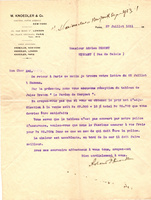
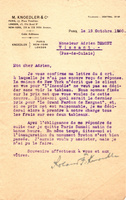
The monograph on Breton, published during the artist’s lifetime by Marius Vachon and listing the artist’s major paintings and the dates of their presentation at the Salon, constitutes a first attempt at a catalogue raisonné.[6] A second publication crucial to the project is the catalogue of the artist’s studio auction at Galeries Georges Petit in Paris on June 2–3, 1911, which included 277 lots. In 1976, the success of an exhibition of the works of Jules and Émile Breton, organized by Françoise Maison at the Musée des Beaux-Arts in Arras, France, which sadly lacked a catalogue, sparked the need for a catalogue raisonné. Bourrut Lacouture, with her in-depth knowledge of the Breton archives, was the logical person to take on the project.
In addition to requiring research in the family archives, the catalogue raisonné project in its early stages required contacting collectors, dealers, museums, and auction houses. It involved traveling to visit museums that owned important works by Breton, including the Pushkin Museum in Moscow, which owns his largest painting, Les Pêcheurs à Menton (The Fishermen of the Mediterranean, also called The Fishermen of Menton) of 1878, measuring 75 ¼ x 100 ¾ in. (191 x 256 cm); and the Museo de Bellas Artes in Cuba, home of Un grand pardon breton (A Grand Pardon in Brittany) of 1869. It also involved countless hours in libraries tracking down provenances and bibliographical references. Every piece of information, collected and handwritten by Bourrut Lacouture, was consigned to paper folders. When personal computers became generally available in the mid-1980s, she transcribed catalogue entries she had already written into a Word document, and completed the entry writing in that same manner.
Moving a Word Document to an Online Platform
Fast-forward to 2017: when the decision was made to publish the Breton catalogue raisonné online, Penot and Pinet came on board as project manager and associate researcher, respectively, to assist Bourrut Lacouture with its completion and digital publication. We realized that selecting the right content-management system was a cumbersome yet crucial task. After considering various options for a web-publishing platform, including proprietary software costing thousands of dollars, we selected the open-source software Omeka.net for its low cost, professional standards, and built-in updates, installations, and maintenance. Omeka.net provides a set number of standardized fields from the Dublin Core Metadata Initiative, which has been widely adopted by scholars and offers users great flexibility.[7] While Omeka.net proved to be a great tool that made entering the Word data and the images relatively simple, its customization was quite time-consuming for art historians who were not technologically savvy. In the default Omeka.net settings, for example, fields that would be expected in a catalogue raisonné related to provenance, bibliography, and exhibition history had to be manually added, along with internal comments, a process that was quite burdensome (fig. 3).
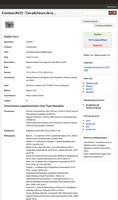
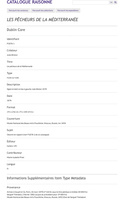
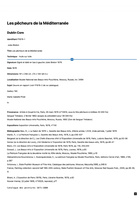
Omeka.net provided an ideal framework for getting the project off the ground, but in time it became clear that it could not be a long-term solution, in part because of the lack of customization and less-than-ideal aesthetic on the front end (fig. 4). The main drawback of Omeka.net was the impossibility of exporting our data, which prevented us from backing it up. Who would protect and preserve the content if the database became hard to maintain, or if its technology became obsolete, or if the server crashed or was hacked? This question, which increasingly preoccupied us, led us to switch from Omeka.net to a custom WordPress management system. Exporting our data to a backup file on a hard drive, whether as a CSV (Comma Separated Values) file, a Word file, or a PDF, was now possible, minimizing our dependency on technologies and the viability of the provider. A custom-made WordPress database also offered a more powerful search engine as well as plug-ins to allow the export of data and a more user-friendly front-end interface (fig. 5). Exporting the data from Omeka.net, however, required hiring a team of coders and software developers and spending the thousands of dollars we thought we had saved when we first opted for Omeka.net. Not only did transferring the data cost us money, it also cost us time. The migration created issues we are fixing to this day. For example, some images were distorted and some entries and key words disappeared, and we unfortunately lost some of the formatting throughout the database, such as italicization. We are currently working tirelessly to make the database user-friendly by adding the appropriate tags for enhanced search capabilities, reloading the images, and italicizing the titles once again, one by one.
Checking and Adding Data
After transferring Bourrut Lacouture’s handwritten notes and the catalogue entries in Word to the Omeka.net platform, the next challenge was conducting extensive research to fact-check and update the nearly one thousand already detailed entries, especially in the categories of bibliography, exhibition history, provenance, and the current location of Breton’s works. New data and new records also needed to be added, as not all of the information Bourrut Lacouture had collected was included in her original Word document. Likewise, some works had been reattributed, and additional works by Breton had surfaced since the time of her initial research.
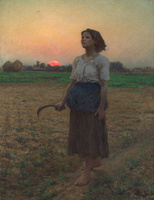
Checking the bibliographical references, in particular, entailed a great deal of work, which was facilitated by new resources not originally available to Bourrut Lacouture, such as WorldCat.org and HathiTrust. In the original Word catalogue, for example, the entry for Calling In the Gleaners listed one hundred bibliographical references; it now includes over two hundred. Yet, while much of the bibliographical research is easier today than it was in the past, when it required seemingly endless trips to different libraries, some of it is now more difficult. For example, quite a few of the numerous Salon reviews listed in Bourrut Lacouture’s original document were no longer available in 2017 due to their physical condition.[8] This was particularly true for the reviews of Breton’s big Salon successes such as Calling In the Gleaners and La Chant de l’alouette (The Song of the Lark; 1884; Art Institute Chicago), which were widely reviewed when they were first exhibited (fig. 6).
It was also necessary to ensure that the current locations of paintings listed by Bourrut Lacouture were up to date. Since auction houses are not allowed to divulge the names of buyers, the locations for many paintings in the catalogue raisonné that had recently sold were listed as unknown, which is not helpful to the catalogue user. Considering that museums or private collectors rarely take the time to share with the preparers of catalogues raisonnés their records of newly acquired or deaccessioned works, tracking down or updating ownership data depended on information provided by dealers or curators or discovered through random internet searches. For example, the location of Les Lavandières des côtes de Bretagne (Washerwomen of Brittany), an important canvas by Breton painted in 1870, was unknown after it was sold at Sotheby’s on April 24, 2009 (lot 85). In 2021, we learned through an online search that it was owned by the Grohmann Museum at the Milwaukee School of Engineering in Milwaukee, Wisconsin.
No fewer than 162 “new discoveries” of works not included in the Word version of the catalogue raisonné were made possible by the use of newly available tools, such as online auction catalogues, dealers’ databases,[9] and other digitized resources,[10] as well as by communicating directly with auction houses and dealers. The Getty Research Institute in Los Angeles, which provides access to the digitized Goupil and Knoedler stock books and corresponding databases, allowed us to track down works once handled by the dealers who built Breton’s international career. Studying these stock books in conjunction with the correspondence in the family archives has helped deepen our knowledge of the relationships between Breton and his main buyers. Most museum websites now include reproductions and descriptions of works in their collections, often accompanied by details on provenance, bibliography, and exhibition history. When a website did not exist for a particular museum, we contacted curators and registrars. Traditional visits to libraries and archives were still necessary, but occurred less frequently than when Bourrut Lacouture began her project.[11]
The preparation of a catalogue raisonné involves not only listing works but also making judgments about their authenticity. It is one of the most challenging tasks. A work may be included in the catalogue despite a lack of archival documentation, with its authentication based solely on the connoisseurship of the author(s) of the catalogue. But these authentications may later be challenged by provenance research. By the same token, such research may prove a work’s authenticity, despite doubts that emerged during its visual inspection. Like most successful painters, Breton had pupils, family members, and friends working with him. He was a revered artist whose works were studied and copied by his apprentices. As a result, many copies of some of his most famous paintings circulate in the market. For example, in the archives of the Musée du Louvre we identified sixty-three full or partial copies of Calling In the Gleaners, Breton’s 1859 Salon success.[12]
Whether a work is included in a catalogue raisonné has substantial financial and art historical repercussions; hence our efforts to examine each work very carefully and analyze all the pertinent information. A decision is sometimes subject to modification when works are inspected using new scientific methods or new documentation comes to light. In recent years, several court cases involving (re)attribution have markedly increased the risk of litigation against authentication committees. In fact, since 2012, the committees for authenticating the work of Andy Warhol, Roy Lichtenstein, Keith Haring, and Jean-Michel Basquiat have been disbanded.
The Jules Breton Catalogue Raisonné in 2023
To lend context and gravitas to the online database, we decided to house it on a well-documented website that includes an introduction, an artist’s biography; a chronology of his life, his work, and key historical events; an essay about our methodology; and a table of contents, similar to what has been done in two digital catalogues raisonnés already published on Egon Schiele and Paul Cézanne. In the future, in addition to maintaining and updating the database, we will publish a series of essays written by prominent experts and we will develop virtual exhibitions. The website is already up and running, but the database, although already integrated, will be made public when the issues mentioned above are addressed and the print publication is released. In the meantime, Penot, Pinet, and Bourrut Lacouture conduct research for individuals on a case-by-case basis.
At its inception, the Jules Breton catalogue raisonné was meant to be a print publication, a tangible product of forty years of work. We decided to maintain this format in addition to the digital catalogue—to have, as Elizabeth Gorayeb, executive director of the Wildenstein Plattner Institute in New York, put it, both a “beautiful object” and a “useful tool.”[13] We are currently working on reconverting the WordPress database to a Word document to prepare it for print publication. We have exported the entries from WordPress and are in the process of compressing them to fit the restricted format imposed by a printed book, while bearing in mind that a book obviously cannot compete with a digital-content management system, which allows for searching, filtering, cross-referencing, and more, depending on its level of customization. Moreover, the color images in a digital publication, which can be enlarged with the movement of two fingers, surpass in quality and flexibility the standard-size color images in traditional books. However, we also know the limitations of an online-only catalogue, notably its dependence on technologies that will inevitably become obsolete. The International Foundation for Art Research (IFAR) publishes a list of catalogues raisonnés on its website, but the list is not widely known or utilized. Furthermore, online publishing offers lower costs up front, but the initial savings can be misleading.
Into the Future
In 2023, Weider established the Jules Breton Foundation, of which Bourrut Lacouture is the first president. The goal of the foundation is to maintain and update Breton’s catalogue raisonné. The foundation will also help promote continued research on, and awareness of, the career and life of Breton for decades to come.
Notes
[1] The data entry phase is now complete and the accompanying website is up: www.julesbreton.com. Online access to the database will be granted after the print edition of the book is published. In the meantime, we offer opportunities for research in the database on a case-by-case basis.
[2] For the catalogue of the exhibition, which opened at the Cleveland Museum of Art and traveled to Brooklyn, NY, St. Louis, and Glasgow, see Gabriel P. Weisberg, The Realist Tradition: French Painting and Drawing 1830–1900, exh. cat. (Cleveland, OH: Cleveland Museum of Art, 1980).
[3] For the catalogue of the exhibition, which opened at the Joslyn Art Museum in Omaha, NE, and traveled to Williamstown, MA, and Memphis, see Hollister Sturges, Jules Breton and the French Rural Tradition, exh. cat. (Omaha, NE: Joslyn Art Museum; New York: Arts Publishers, 1982).
[4] For the catalogue of the exhibition, which opened at the Musée des Beaux-Arts in Arras, France, and traveled to Quimper and Dublin, see Annette Bourrut Lacouture, Jules Breton (1827–1906): La Chanson des blés, exh. cat. (Paris: Somogy, 2002). The exhibition was reviewed in Nineteenth-Century Art Worldwide.
[5] Letters from Knoedler to Virginie Demont-Breton and Adrien Demont, July 27, 1911; June 12, 1915; October 30, 1918; October 19, 1920; September 27, 1926; and January 7, 1929, Jules Breton family archives, Paris, France. The painting was acquired in 1994 by the Musée des Beaux-Arts in Quimper.
[6] Marius Vachon, Jules Breton (Paris: A. Lahure, 1899).
[7] For an explanation of how Omeka.net works with the Dublin Core Metadata Initiative, see “Working with Dublin Core,” Omeka Classic User Manual, Omeka, https://omeka.org/.
[8] See, for instance, Courrier du Pas-de-Calais, JO-12763, Bibliothèque Nationale de France, Paris, which was not circulating in 2017.
[9] The Getty Research Institute databases we consulted include both Goupil & Cie and Knoedler & Co., accessible via the Getty Provenance Index, https://piprod.getty.edu/. We also consulted Knoedler’s photo library in the research institute’s Department of Special Collections (boxes 2068 and 2069, 2012.M.54), and the digitized stock books of the dealer Thos. Agnew and Sons at the National Gallery in London (“Agnew’s Stock Books,” NGA 27, Thos. Agnew and Sons Ltd. Archive, Research Centre, National Gallery, London, https://www.nationalgallery.org.uk/).
[10] The Institut National d’Histoire de l’Art (INHA) provided access to Frits Lugt’s records of sales until 1900. Also useful was the Wildenstein Plattner Institute’s digitized library, available at https://wpi.art/. We often used Gallica, the Bibliothèque Nationale de France’s digitized-document portal, for nineteenth-century exhibition and sales catalogues, available at https://gallica.bnf.fr/.
[11] The documentation service at the Musée d’Orsay in Paris has five boxes dedicated to Jules Breton. The Archives de Paris—especially the Commissaire-priseurs procès verbaux, detailed records of auction sales in France—were invaluable for identifying the buyers at the Jules Breton studio sale in 1911, and whenever possible, the buyers and sellers at every sale from a Parisian auction house that offered a work by Jules Breton.
[12] 20150337/430–20150337/438, Série LL, Archives des Musées Nationaux, Musée du Louvre, Paris.
[13] Quoted in Georgina Adam, “It Is Time for Catalogues Raisonnés to Join the Digital Age,” Art Newspaper, December 1, 2020, www.theartnewspaper.com/.